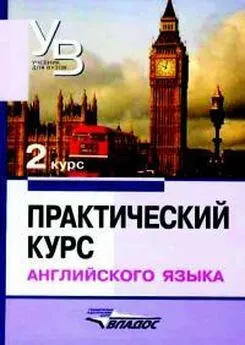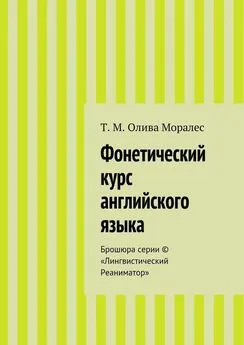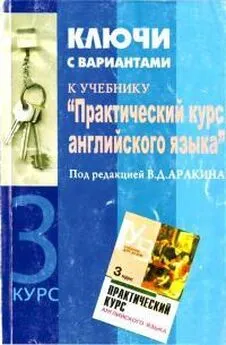Яков Аракин - Практический курс английского языка 2 курс
- Название:Практический курс английского языка 2 курс
- Автор:
- Жанр:
- Издательство:ВЛАДОС
- Год:2005
- ISBN:нет данных
- Рейтинг:
- Избранное:Добавить в избранное
-
Отзывы:
-
Ваша оценка:
Яков Аракин - Практический курс английского языка 2 курс краткое содержание
I - V курсов педагогических вузов.
Цель учебника – обучение устной речи на основе развития необходимых автоматизированных речевых навыков, развитие техники чтения, а также навыков письменной речи.
Практический курс английского языка 2 курс - читать онлайн бесплатно полную версию (весь текст целиком)
Интервал:
Закладка:
The middle or body of the composition in its turn makes the problem clear through narration,
description, argument or exposition (compare different passages from this textbook). Usually the
middle includes the details. It may have the turning point or climax describing the moment of
greatest emotions.
The end or conclusionis the result of that clarification. The author provides an answer to
the main question. It is usually marked by a summary statement emphasizing the message (compare
the final sentences in "A Day's Wait", "How We Kept Mother's Day", "Rose at the Music-hall").
Assignments:
1. Write a composition explaining the message of the passage "Rose at the Music-ball.
2. Write a composition following the events described in the pictures on pp. 338-339.
3. Write a composition describing your visit to a theatre and your impressions of the
prevailing atmosphere,
4. If you have become proficient at writing compositions as an exercise you may turn to
teaming how to write compositions as art. Try your hand at writing a composition about the
best way to comfort your mother (father, child, sister or brother, friend).
Evaluate your composition according to the main principles of good writing: unity,
coherence, and emphasis.
LABORATORY EXERCISES (II)
1. Listen to the text "Drama, Music and Ballet in Britain", mark the stresses and tunes.
Repeat the text following the model.
2. Record the dialogue "At the Box-Office" in pairs. Listen to the records and discuss
them in class.
3. Listen to the dialogue "Pantomimes", mark the stresses and tones. Repeat it
following the model.
4. Write a spelling-translation test:
a) translate the phrases into English;
b) check them with the key.
5. Respond to the following questions or statements and correct them if necessary.
6. Listen to the story. Write ten questions about the text. Suggest a title for the text and
give reasons for your choice. Find evidence in the text to support the following statements.
CURIOSITY QUIZ FOR EAGERS
1. What do you know about K. S. Stanislavsky, his role in the history of the Moscow Art
Theatre and bis influence on world theatre?
2. Where do the following quotations come from? Who says the lines? Under what
circumstances?
a) The time is out of Joint Oh, cursed plight. That ever I was bom to set it right '
b) Beware, my lord, of the jealousy;
It is the green-eyed monster, that doth mock The meat it feeds on.
c) How sharper than a serpent's tooth it is To have a thankless child.
3. What do you know about the problem of Shakespeare's authorship?
4. What do you know about the Sovremennik Theatre? about the Lenkom Theatre?
about the Tovstonogov Theatre in St Petersburg?
5. Listen to a text connectid with the topic "Theatre".
SUPPLEMENT
A. CLASSROOM ENGLISH
I. Pupil Language
This section contains a list of phrases that pupils might be expected to use during an English
lesson.
1. Following the Lesson
I'm sorry, I didn't understand.
You're speaking too quickly.
I didn't get that down. Could you say it again?
Could you repeat the last bit?
I missed the beginning of what you said.
Could you explain again, please?
Shall we do the exercise in our work books?
Are we supposed to finish this off at
home?
What do we have to do next?
Could you write it up on the board,
please?
Is it my turn? (Am I next? Shall I start?)
2. Correctness of Answers
Why can't you say ...? Is this a mistake?
What's wrong with (saying)...?
Why did you mark this wrong?
Why did you put a line under this
word?
Isn't there a mistake in sentence 3?
Shouldn't there be an article?
I think you've made a mistake on the board.
3. Language Questions
How do you spell...? Are there two ‘l’s or only one?
How do you pronounce the next word?
I'm not sure how to say the next word.
Could you use the future (passive) here?
Can we leave this out (miss this out) ?
Is there a shorter (better) way of saying this?
4. Politeness
I'm sorry I'm late; I've been to ...
I'm afraid I've left my book at home.
Could I leave ten minutes earlier (at twenty to ...)?
Could I have another copy?
Have you got an extra sheet?
Shall I turn the lights out?
II. Beginning of Lesson
Let me introduce myself, I'll be teaching you English this year.
It's time to start now, / We can get down to (some) work.
I'll just mark the register. Who is missing (away, not here today) ?
Try not to be late next time.
I'm waiting to start.
III. End of Lesson
There's the buzzer (bell). / We'll have to stop here.
Right. You can put your things away and go.
How are we doing for time?
There are still three minutes to go.
We still have a couple of minutes left.
Hang on a moment/just hold on a minute.
One more thing before you go.
Revise what you did today and then try exercise 5.
Do the rest of the exercise as your homework for tomorrow.
There will be a test on this next Tuesday (in the near future).
IV. Blackboard Activity
Come out to the board, please (when the teacher is at the front of the class).
Go to the board (when the teacher is standing at the back of the class).
Move out of the way (step aside) so that everyone can see.
Is there anything to correct (that needs correcting)?
What letter is missing? There's àk' missing (`k' is missing).
Cross the 't's and dot the ì' s.
Write it with a capital `j' (it begins with a 'j').
Write it as one word (two words).
These two letters are the wrong way round.
Put a comma (question mark, exclamation mark, colon, semi-colon, full stop) after the word
(sentence), please.
Enclose the words in quotation marks (inverted commas), please.
Let's all read the sentences from the board.
Use the duster (sponge).
Put (take, get, write, copy) that down in your notebooks.
Make notes on what I say in your exercise books.
Write it in block (big) letters (in block capitals).
Write (rewrite) it neatly.
Do the exercise in writing.
Will you, please, go to your seat. (Don't say 'Sit down' if a pupil is not standing at his seat.)
Hand in your papers as you leave (go out) and make sure your names are on them.
V. Slides, Pictures, Films
I'll finish the class by showing you a film (some slides).
Put the screen up (pull down the screen).
Draw the curtains (close the blinds).
Lights out, please. Switch on the projector.
Who would like to work (operate) the projector today ?
Turn the lights on again (put the lights back on).
Next picture, please/change the picture.
It's a bit out of focus.
I'm afraid this one is upside down.
What is happening in this picture?
What can you see in the foreground (background, centre, right-hand corner, the top left-hand
corner, at the bottom) of the picture?
I'll let this photograph go round. Have a look and then pass it on.
Pass this picture round.
Come out and point to London on the map.
VI. Textbook Activity
Collect in the papers (sheets, texts, word lists, handouts, tests), please.
Fetch the dictionaries from the teacher's room (staff-room).
You will have to share (your book) with Nick.
Take out your books and open them at page 27 (Unit 2).
You'll find the exercise on page 38.
Let's move on to the next page.
Refer back to the grammar notes on page 25.
All books closed, please (shut your books).
The picture at the top (bottom) of the page (at the very top).
(The) tenth line from the top (bottom) = (down/up).
(The) last but one line (word) in paragraph two.
If there are any words you don't know, please ask.
Read one sentence each.
Ann, you read the part of Mrs. White this time.
Now let's act out this dialogue.
Try and act like a teacher (a dentist, etc.).
The rest of you are the audience.
Give a synonym for 'rushed'. (What is a synonym for 'huge'?)
Try to put it in other words.
(That was almost right) — just one little slip. There was a small (slight) mistake (error) in
what you said.
VII. Class Control
Could I have your attention, please?
Look this way. / Look up for a moment.
Be quiet! Everyone listen.
Don't all shout. / Don't talk at once.
Get on with your work quietly.
Stop fidgeting. / Don't keep turning round.
Sit up (straight).
Work in twos (pairs).
I want you to form groups. Three pupils in each group.
I want you to do some play reading in groups.
Work on your own. / Work by yourselves.
Look! I've just about had enough from you.
Don't you talk, you two girls.
Don't sit there day-dreaming, Maria.
VIII. Right /Wrong
Good. Right. Fine. Right you are. Quite right.
That's the way. That's right. That's it. That's correct.
Yes, you've got it You've got the idea.
What you said was perfectly all right.
You didn't make a single mistake.
That's exactly the point.
That's just what I was looking for.
No, that's wrong. Not really. Unfortunately not.
You can't use that word here.
You missed the verb out.
You forgot the preposition. Mind the preposition.
You used the wrong tense.
You misunderstood the instructions.
Once again, but remember the word order.
Try not to mix these two words up.
They're spelt the same, but pronounced differently.
Perhaps you had better say ...
It wasn't pronounced correctly. The word is accented on the second syllable.
Be careful with the 'sh'-sound.
Notice how my tongue touches my teeth. See how my mouth hardly moves.
Again please, but watch your pronunciation.
Listen to the way my voice goes up.
You must let your voice fall at the end of the sentence.
Let's see if you've spelt it right / correctly.
You need an extra letter here.
Rub out the wrong word. Wipe out / off the last letter.
Always check the punctuation.
Don't translate word for word.
Think about the meaning of the whole sentence.
You find it difficult to read aloud.
You'll have to spend more time practising this.
Speak more clearly. Not so quickly, I can't follow.
There was a mistake in that sentence. Go back and see if you can find/spot it.
Don't whisper the answer. Don't help him. Don't keep prompting.
I'm sure she can manage on her own.
Читать дальшеИнтервал:
Закладка:





![Владимир Аракин - Практический курс английского языка 3 курс [calibre 2.43.0]](/books/1072035/vladimir-arakin-prakticheskij-kurs-anglijskogo-yazyk.webp)




